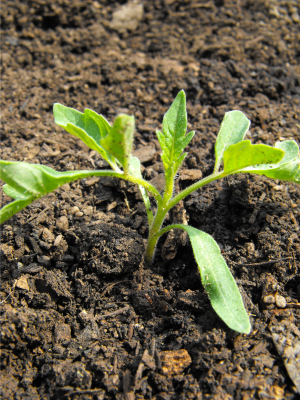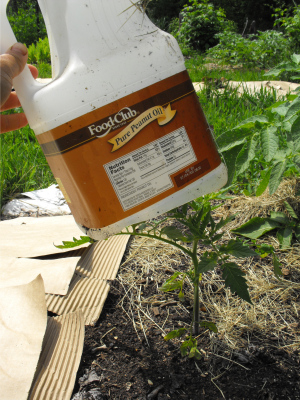
Tomato experiments
 The
tomato
blight of 2009 left
me close to tears last summer, and with a serious
craving for red sauce this spring. This year is also a tomato
seed turning point. I last saved seeds in 2007, assuming that I
could collect more in 2009, but I didn't manage to harvest any tomato
seeds before the blight hit. This spring, my three year old seeds
had low germination percentages, so I absolutely must have ripe
tomatoes to save seeds from this year or I'll have to rebuild my
collection of the
tastiest and most utilitarian tomato varieties from scratch.
The
tomato
blight of 2009 left
me close to tears last summer, and with a serious
craving for red sauce this spring. This year is also a tomato
seed turning point. I last saved seeds in 2007, assuming that I
could collect more in 2009, but I didn't manage to harvest any tomato
seeds before the blight hit. This spring, my three year old seeds
had low germination percentages, so I absolutely must have ripe
tomatoes to save seeds from this year or I'll have to rebuild my
collection of the
tastiest and most utilitarian tomato varieties from scratch.
So I'm experimenting
with spacing, location, and timing in search of a
blight-free tomato harvest. The goal of the first two experiments
is to allow lots of sunlight and air movement around the plants so that
they'll dry off quickly after rains. To that end, I've planted
all of our tomatoes in the sunniest part of the garden, and am doubling
the spacing between plants to three feet. In addition, we'll be
individually staking the plants and pruning off the suckers to promote
even speedier drying.
 Meanwhile,
I'm trying three different planting
times/ages. I've discovered in the past
that young seedlings started
in a cold frame then
transplanted to the garden do better than
leggy
tomato plants that have been struggling on a windowsill for
months. So the majority of my plants have just been transplanted
out at
the two sets of true leaves stage.
Meanwhile,
I'm trying three different planting
times/ages. I've discovered in the past
that young seedlings started
in a cold frame then
transplanted to the garden do better than
leggy
tomato plants that have been struggling on a windowsill for
months. So the majority of my plants have just been transplanted
out at
the two sets of true leaves stage.
On the other hand, my
neighbors believe in buying big transplants and
putting them out earlier, covering the plants with bottomless milk jugs
during cold spells and hoping that they will bear at least some harvest
before blight sets in. A volunteer tomato came up in our lemon
pot in the sunroom this spring, and I decided to transplant it out into
the garden on April 21 to see how its growth compares to that of my
younger transplants --- it's currently big and hefty, with about six
pairs of true leaves.
Finally, my father
likes to tell me that he once direct-seeded tomatoes into the garden
after all danger of frost was past and still got harvests nearly as
quickly as from transplants. So I filled the last tomato spot
with ten seeds and will weed the seedlings down to the strongest one
once its up. Will it catch up with its transplanted
siblings? Only time will tell.
If all else fails, I
have one last trick up my sleeve. One
volunteer tomato plant survived the blight of 2009, and I carefully
saved its seeds to add to my collection. I have high hopes that
at least this one variety will be resistant enough to give me a
crop. Here's hoping something works!
| This post is part of our Farm Experiments lunchtime series.
Read all of the entries: |
Want more in-depth information? Browse through our books.
Or explore more posts by date or by subject.
About us: Anna Hess and Mark Hamilton spent over a decade living self-sufficiently in the mountains of Virginia before moving north to start over from scratch in the foothills of Ohio. They've experimented with permaculture, no-till gardening, trailersteading, home-based microbusinesses and much more, writing about their adventures in both blogs and books.
Want to be notified when new comments are posted on this page? Click on the RSS button after you add a comment to subscribe to the comment feed, or simply check the box beside "email replies to me" while writing your comment.
- Remove comment
- Remove comment
